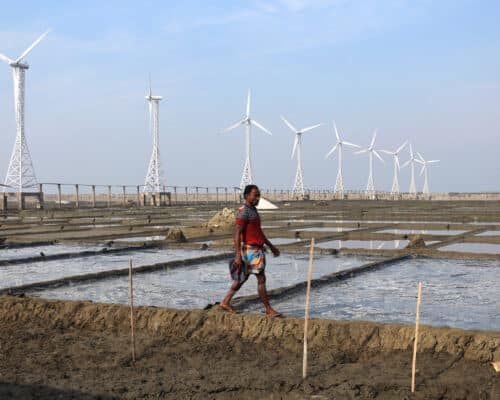High Energy Prices Wreak Havoc on Sri Lankan, Bangladeshi and Pakistani Economies
Photo by AlexanderStock
21 November 2022 – by Tim Daiss
High energy prices are wreaking havoc on the economies of several developing countries in South Asia, including Sri Lanka, Bangladesh and Pakistan. These developments are also widening the energy poverty gap between developed and developing nations.
Before Russia’s invasion of Ukraine in late February – a conflict that sent global gas prices to record-highs – Sri Lanka, Bangladesh and Pakistan had set their hopes on LNG. Hailed as a way to diversify their respective power generation mixes away from an overreliance on coal, LNG was to be used in lieu of building out more renewable energy.
Much of the decision to take up LNG came from the global gas sector’s narrative that gas would be the “perfect” transition fuel until the cost of solar and wind power projects became lower.
Unaffordable LNG Prices Take Hold
However, record-high LNG prices in the Asia-Pacific region for both spot procurement and LNG-indexed crude oil have raised doubts regarding that narrative. Prices for the liquid-cooled fuel hit a record-high of close to $60/MMBtu price point earlier this year, a new high, pared gains for several months after that, then settled in the still cost prohibitive $30s/MMBtu range.
High LNG prices this year have also created demand destruction for the fuel. This is especially the case in Asia – an area home to around two-thirds of global LNG demand. In the first eight months of the year, nearly 40% of tendered cargoes weren’t awarded due to excessively high bid prices. This is compared to a rejection rate of 35% in 2021 and an average of less than 20% in 2015-2020, according to the International Energy Agency’s (IEA) Gas Market Report, Q-4 2022.
Sri Lanka Still Holding on to LNG Plans
Sri Lanka, not yet an LNG-importing nation, is nonetheless undergoing an economic crisis. The main causes are the escalating energy prices and the corresponding inflation. The situation has driven many in the country into poverty. It has jeopardised people’s rights to health, education, and adequate living standards, according to a Human Rights Watch (HRW) report.
Amid the economic fallout, Sri Lankans have taken to the streets in protest since the start of the year. The protests forced the resignation of President Gotabaya Rajapaksa, leading to Ranil Wickremesinghe becoming president on July 21.
The new government has been negotiating with foreign creditors to restructure debts on which Sri Lanka defaulted in May. It is also in negotiations with the International Monetary Fund (IMF) for a bailout, the HRW report added.
Meanwhile, the inflation rate in Sri Lanka averaged just over 70% in August. This has made key imports like fuel, fertiliser and medicine unaffordable for many.
Economic and political instability, however, hasn’t stopped the government’s LNG development ambitions. It’s still pushing through with its planned floating storage and regasification unit (FSRU) to import LNG, as well as two gas-to-power projects.
Bangladeshi Gas Pains
According to the IEA’s Gas Market Report, Bangladesh, once called South Asia’s economic miracle, has seen its LNG imports drop by 20% up to July.
There were also no spot LNG purchases during the July to August period due to high prices for the fuel. Currently, Bangladesh imports LNG via its two terminals.
However, like Sri Lanka, Bangladesh’s energy supply crisis has created economic and political turmoil. Earlier this month, the IMF was in the country negotiating a financial rescue package. The reasons given include less money being spent on Bangladeshi clothing exports from its main buyers in the US and Europe, as well as the high energy prices.
As global fuel prices spiked on international markets, the Bangladeshi government subsidised local fuel prices even more. This drained government coffers, according to NPR’s Lauren Frayer.
When the government was finally forced to stop fuel subsidies, the prices of gas, diesel, kerosene and cooking gas shot up by 50%. This reverberated through the economy and sent thousands of people to the streets in protest.
Pakistan’s Energy Quandary and Political Turmoil
Pakistan has also suffered a deep energy crisis with economic implications. It has created political turmoil and the ushering in of a new government amid the uncertainty. High energy prices have also caused people to experience rolling blackouts for up to 12 hours at a time.
Pakistan’s LNG imports for the first months of 2022 dropped 19% year-on-year. Spot purchases dried up to what the IEA calls a “bare minimum”.
Pakistan also imports LNG via its two terminals.
Moreover, the country’s oil imports needed for power generation jumped fivefold, creating even more emissions from its energy sector.
Global oil prices have worsened Pakistan’s financial woes. Oil prices breached the $100 per barrel price point earlier this year for the first time since 2014. They then spiked to $124 for Brent crude in May, a nine-year high. Prices have since trended downward but are still hovering around the $90 per barrel price point.
The Way Forward
As Sri Lanka, Bangladesh and Pakistan grapple with an economic calamity from high energy prices, the way forward would be to reduce gas and oil overreliance and cancel plans for new fossil fuel project development while building out more renewable energy. Solar and wind power projects are also much faster to build than their LNG counterparts.
Funding could come from the Asian Development Bank (ADB), World Bank, IRENA, Japan International Cooperation Agency (JICA), USAID and others. Lead funding from several of these agencies could also help offer risk mitigation. Such areas include currency risk, political risk, regulatory risk and liquidity risk, to name a few. With these agencies taking the lead, less experienced and well-funded local banks could also offer loans. Moreover, risk mitigation could also lower upfront project development costs by lowering borrowing rates.






